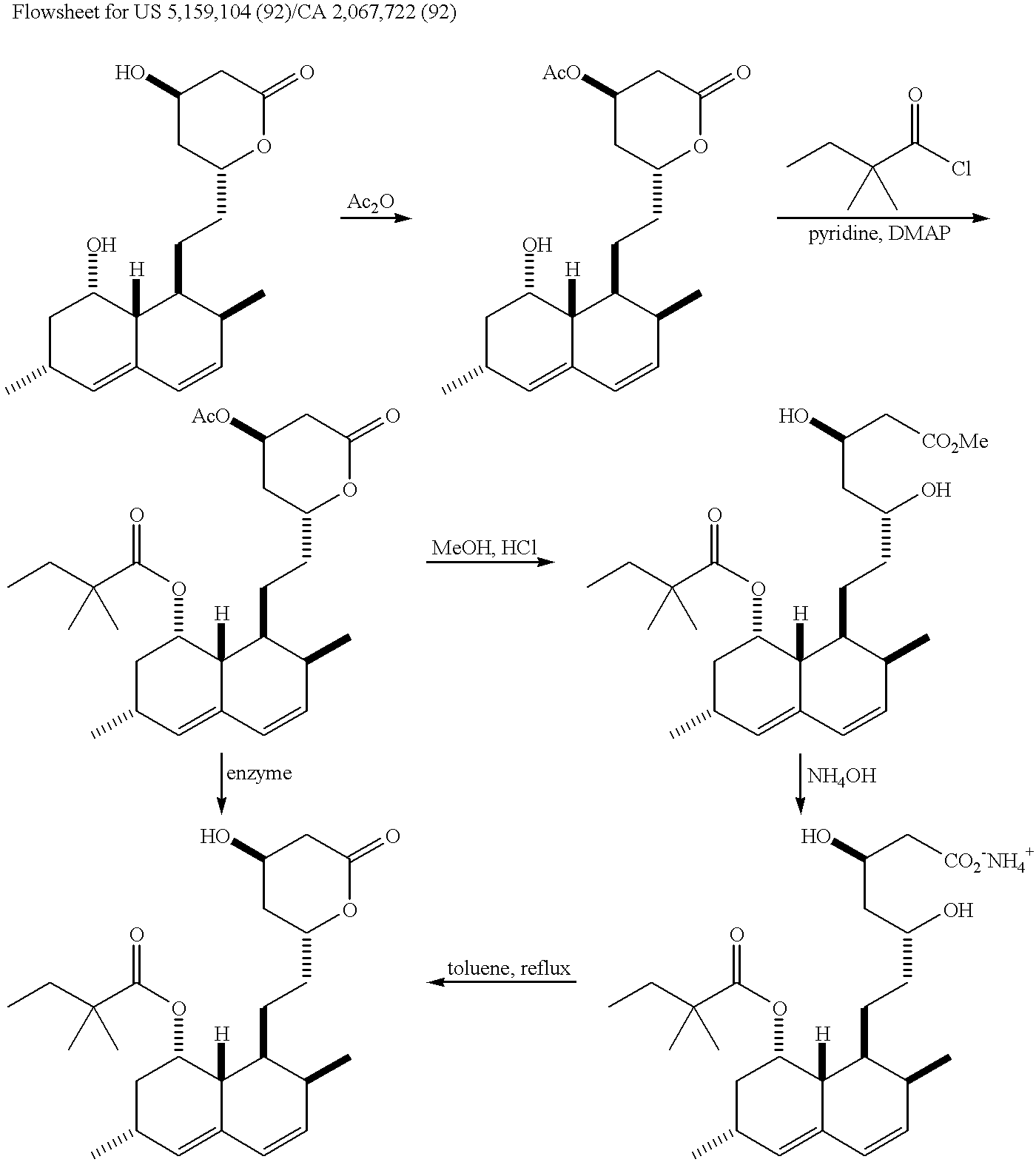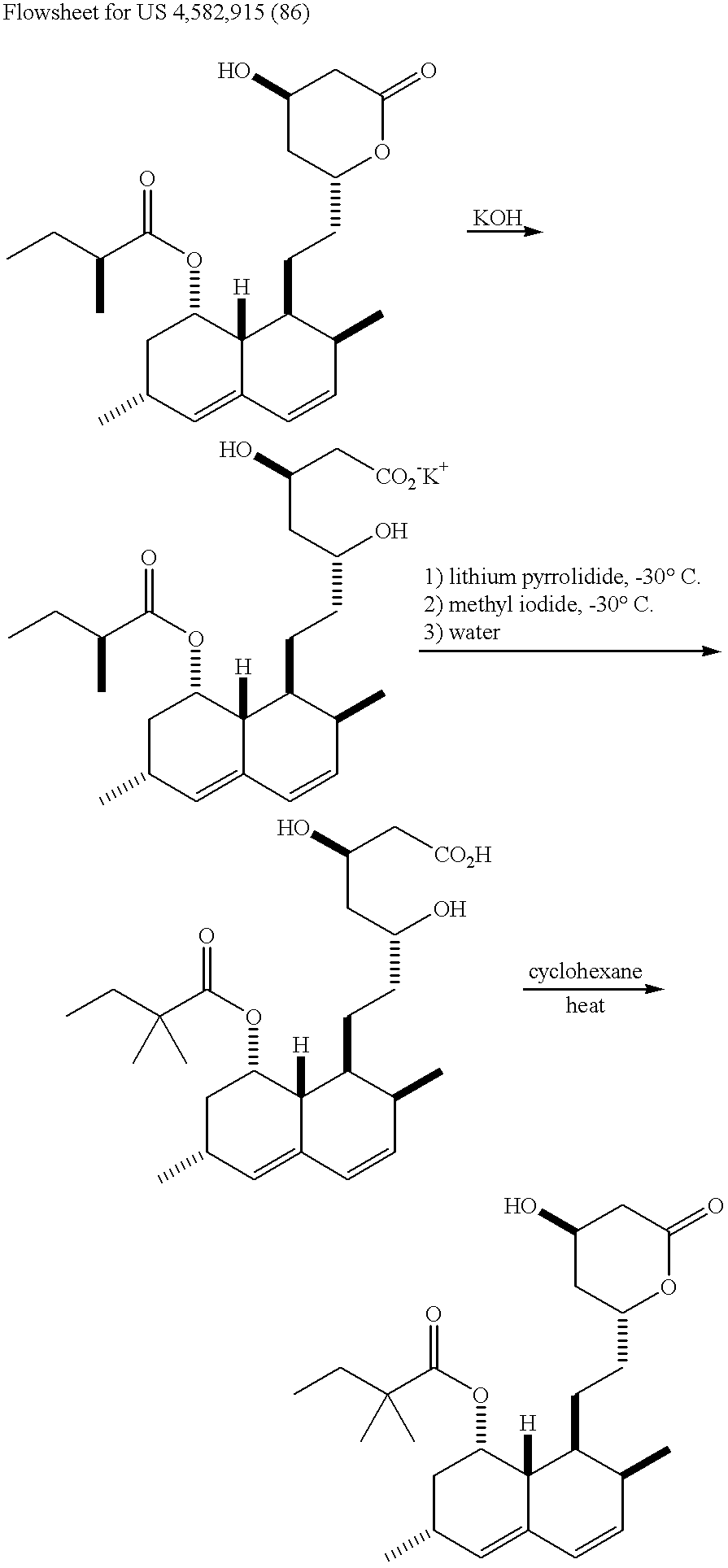Process for producing simvastatin
a technology of simvastatin and process, which is applied in the field of process for the preparation of simvastatin, can solve the problems of insertion and removal, and the necessity of relactonization
- Summary
- Abstract
- Description
- Claims
- Application Information
AI Technical Summary
Benefits of technology
Problems solved by technology
Method used
Image
Examples
example 1
Preparation of Lovastatin Phenylboronate
A suspension of lovastatin (350 g, 0.865 mmol), phenylboronic acid (110.8 g, 0.909 mmol) and toluene (1.75 L) was heated with agitation under a nitrogen atmosphere. A reflux temperature of 100-105.degree. C. was maintained for 55 minutes as water was collected and separated from the reaction mixture. The solution was cooled and 1.39 L of toluene was removed by vacuum distillation at 40-50.degree. C. The concentrated solution was treated with hexanes (3.15 L) between 40-50.degree. C. The resulting suspension was cooled to 0-5.degree. C. for 2 hours and the product was filtered and washed with 0-5.degree. C. hexanes (350 mL). The product was dried at 35-40.degree. C. under vacuum to provide 427.9 g (37%) of lovastatin phenylboronate at >99% purity by HPLC.
example 2
Alkylation of Lovastatin Phenylboronate Using Lithium Pyrrolidide
A 2L 3-necked flask was charged with pyrrolidine (56 mL, 0.67 mol) and dry THF (453 g) under a nitrogen atmosphere. n-Butyllithium (419 mL, 1.6 M hexane solution, 0.67 mol) was added dropwise at a temperature between -20 and -25.degree. C. over a period of 1 hour. The solution was maintained at this temperature for 30 minutes and then cooled to -55 to -60.degree. C. A solution of lovastatin phenylboronate (101.7 g, 0.20 mol) in 274.7 g of THF was cooled to a temperature of -50.degree. C. and then added to the cold lithium pyrrolidide solution at a rate such that the internal temperature was between -50 and -55.degree. C. during the addition. The reaction was held at this temperature for 4 hours and then methyl iodide (116.4 g, 0.82 mol) was added at a temperature below -55.degree.C. The reaction was stirred for 13 hours at -15 to -20.degree. C. and then quenched with 500 mL of 2M HCl at a temperature below 0.degree. C....
example 3
Alkylation of Lovastatin Methylboronate Using Lithium Pyrrolidide
According to the method described in Example 2, from 8.9 g of lovastatin methylboronate there was obtained simvastatin methylboronate of >90% purity in 96% yield.
PUM
| Property | Measurement | Unit |
|---|---|---|
| pKa | aaaaa | aaaaa |
| temperatures | aaaaa | aaaaa |
| temperatures | aaaaa | aaaaa |
Abstract
Description
Claims
Application Information
 Login to View More
Login to View More - R&D
- Intellectual Property
- Life Sciences
- Materials
- Tech Scout
- Unparalleled Data Quality
- Higher Quality Content
- 60% Fewer Hallucinations
Browse by: Latest US Patents, China's latest patents, Technical Efficacy Thesaurus, Application Domain, Technology Topic, Popular Technical Reports.
© 2025 PatSnap. All rights reserved.Legal|Privacy policy|Modern Slavery Act Transparency Statement|Sitemap|About US| Contact US: help@patsnap.com



